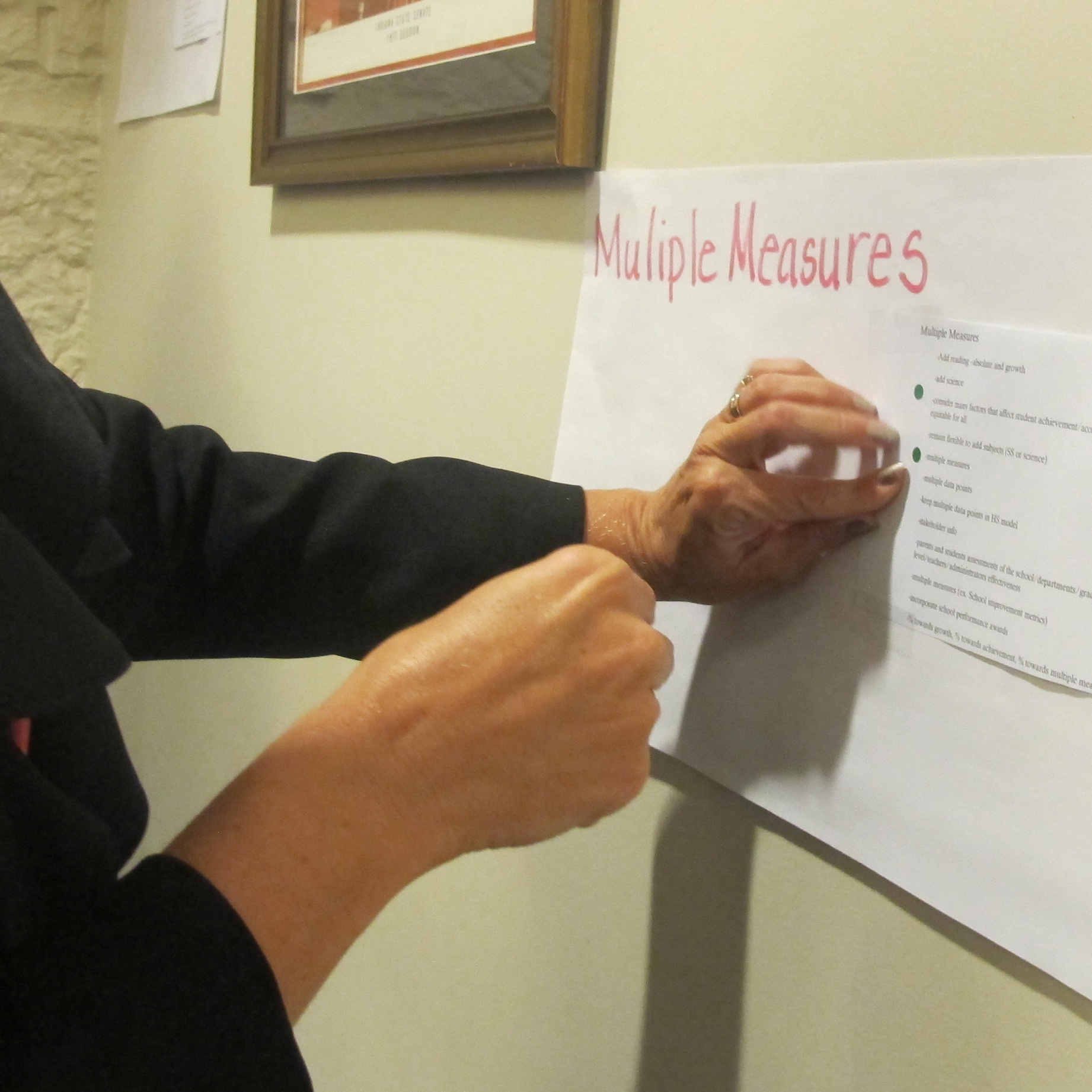For Handful Of Schools ‘Harmed’ In Bennett A-F Grade Changes, What Are The Options?

Kyle Stokes / StateImpact Indiana
Superintendent of Public Instruction Glenda Ritz chairs the September 2013 meeting of the State Board of Education.
Though Tony Bennett‘s controversial changes to Indiana’s A-F school rating formula left more than 160 schools with higher grades, another relative handful of schools saw worse grades.
Should state officials throw those grades out? Keep them? Raise them? And what about next year’s grades?
Those are the thorny questions Bennett’s successor, state superintendent Glenda Ritz, will put to Indiana’s top education policymaking body Wednesday.
Ritz “will be presenting options… but not making specific recommendations” to the State Board of Education at its monthly meeting this week, a Department of Education spokesperson tells StateImpact.
But the analysts called the last-minute changes Bennett’s staff made to the A-F formula “plausible,” adding the changes were “consistently applied” to schools across the state — not just Christel House Academy, a well-regarded Indianapolis charter school whose namesake is also a prominent GOP donor.
What’s The Problem, Again?
The trouble with Bennett’s A-F model, Ritz contends, is that it doesn’t account for schools with combinations of grade levels that are different from the traditionally-configured elementary, middle or high schools.
For instance, Hammond Academy — a charter school in northwest Indiana — enrolls students in grades 6 through 11, meaning its students take the same tests as middle schoolers (the ISTEP+) and high schoolers (the End-of-Course assessments). But the school also lacks one data point used to configure a high school’s grade: a graduation rate.
Christel House Academy (a K-11 school) lacked a graduation rate too. State officials figured in 2012 the fact the school was missing a key data point was unfairly hurting its score, so they disregarded Christel House’s “awful” high school scores in calculating its A-F grade.
In Hammond Academy’s case, though, this change brought their grade down from what would have been a D to an F. (School Matters‘ Steve Hinnefeld identified this fact a few weeks ago, by the way.)
So What Options Does The State Board Have?
This is where things get complicated. Suffice it to say, the State Board is at least scheduled to sort it all out on Wednesday. The discussion could be lengthy and complicated.
If you’re happy with that answer, you can click away from this post now. If you want to come into the weeds with us, continue reading.
Still with me?
Okay.
With the A-F recommendations listed as an “Action Item” on Wednesday’s agenda, the State Board is likely to take a vote directing state officials what to do about not only the 2012 school grades, but about calculating the forthcoming 2013 school grades.
So first, last year’s grades:
- Hammond Academy. State Board members will consider changing the school’s grade. They could give it a D or they could void Hammond Academy’s 2012 grade. Or they could keep the school’s grade as it is — an F.
- Do No Harm? Three other schools — Indianapolis’ Damar Charter Academy, Fort Wayne’s Cornerstone College Prep and the Career Academy at South Bend — received F’s. But because, like with Hammond Academy, state officials calculated these schools’ grades based on only the elementary model, Ritz raises the possibility that these schools’ F’s could be voided too, leaving the schools without 2012 grades.
- Subscore Ceiling. Three high schools benefited from removing the “subscore ceiling.” (If you want to understand that, you should read this and watch this.) Unlike with the elementary and middle school model, where there’s some ambiguity whether this ceiling should exist, Ritz says the high school model clearly states the ceiling should not exist. For this reason, she says the State Board could decide to preserve the A’s that Brazil’s Northview High School, Speedway High School and Rossville High School all received. They could also opt to recalculate their grades. With a subscore ceiling in place, these schools would all have received B’s.
And what about next year’s grades?
Ritz is currently co-chairing a panel of educators that’s re-writing the state’s A-F grading system as it will apply to schools’ grades in 2014-15.
But this year, state officials will use the Bennett-era model once again. That leaves the State Board with several decisions to make — particularly as it pertains to those schools with unusual grade configurations.
Should these unusual schools receive no grades this year? Get grades in the same way as they did last year? Modify the grading model to account for these different school types? Or should the State Board treat each of these schools on a case-by-case basis?
And should the State Board, for consistency’s sake, continue to grade schools without the subscore ceiling, as Bennett’s team did? Or should they replace the subscore ceiling for elementary and middle schools (as Ritz says they must with high schools)?
All of these options are on the table at Wednesday’s meeting.




